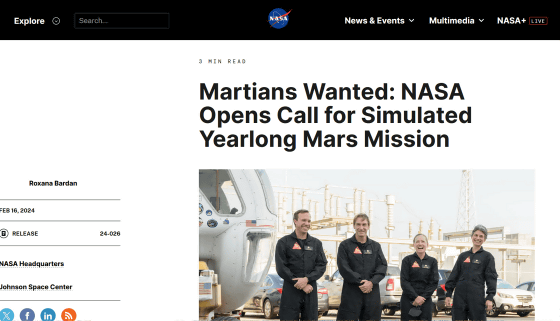NASA is recruiting participants for ``an experiment to live for one year in a simulated environment on Mars'' and will engage in simulated extravehicular activities in an environment with limited resources.

NASA is planning future human exploration of Mars, but living in an isolated environment for long periods of time may have unexpected effects on astronauts. Therefore, NASA is conducting an experiment called ' Crew Health and Performance Exploration Analog (CHAPEA) ' in which four subjects live for one year in a habitat simulating the Martian environment, and is recruiting participants for the next CHAPEA mission, which will begin in the spring of 2025. doing.
Martians Wanted: NASA Opens Call for Simulated Yearlong Mars Mission - NASA
https://www.nasa.gov/news-release/martians-wanted-nasa-opens-call-for-simulated-yearlong-mars-mission/

CHAPEA - NASA
https://www.nasa.gov/humans-in-space/chapea/
NASA Offers Dream Job For Space-Lovers! A Year-Long Mars Simulation : ScienceAlert
https://www.sciencealert.com/nasa-offers-dream-job-for-space-lovers-a-year-long-mars-simulation
Humans have already achieved manned exploration of the lunar surface, but Mars is much further away than the Moon, and it takes seven to nine months just to get to Mars, and the Mars mission requires building a settlement on the surface of Mars. Long-term stays are also planned. Therefore, astronauts participating in manned exploration missions to Mars will spend long periods of time in isolated environments.
Therefore, NASA created a Mars-simulating habitat called 'Mars Dune Alpha' at the Johnson Space Center in Houston, Texas, USA, and conducted an experiment called 'CHAPEA' in which four subjects lived there for one year. going. A total of three missions are scheduled for CHAPEA, and the first mission is in progress at the time of article creation.
The habitat used in CHAPEA, which simulates the Martian environment, is created using 3D printers. The habitat is 1,700 square feet (approximately 158 square meters), and subjects are forced to live with limited resources, as well as equipment failures, communication delays, and other environmental stressors. It is said that the problems that may occur in the future are also being imitated.
Sneak Peek at Simulated Mars Habitat at NASA's Johnson Space Center - YouTube
The situation of the subjects participating in the first mission is like this. The mission, which began on June 25, 2023, will reach the halfway point at the end of 2023 , and the subjects are doing quite well so far.

The subjects not only live their lives, but also perform tasks that astronauts would perform in real life, such as simulated spacewalks, operating robots, maintaining a habitat, exercising, and growing crops.

We also cultivate crops within our settlement, and we successfully harvested our first crop in October.

NASA has begun recruiting four subjects to participate in the second CHAPEA mission, scheduled to begin in spring 2025. The eligibility requirements are the same as for the regular astronaut exam: applicants must be between 30 and 55 years old, a U.S. citizen or permanent resident who is fluent in English, in good health, and a non-smoker with no criminal record. Required candidates have at least a master's degree in a STEM field and at least 2 years of specialized STEM experience or 1000 hours of experience as an aircraft pilot. Additionally, because the mission itself is extremely demanding and long-term, you must have a strong desire for a unique and rewarding adventure and an interest in contributing to NASA's work toward human exploration of Mars. thing.
The deadline for online applications is Tuesday, April 2, 2024, and the selection process is expected to take up to 14 months. In addition, NASA says that the reward for participating in the mission will be notified at the candidate screening stage.
Related Posts:
in Science, Posted by log1h_ik







